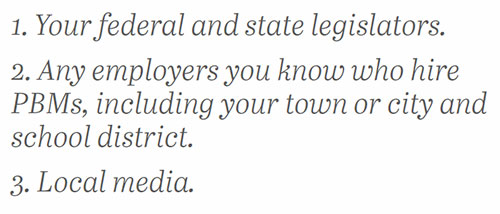Dear Colleague,
 "The Opaque Industry Secretly Inflating Prices for Prescription Drugs." That was the headline of a blockbuster New York Times article that had Capitol Hill buzzing. Reporters Rebecca Robbins and Reed Abelson have been investigating PBMs for months, and last week the first article in their series ricocheted around the internet.
"The Opaque Industry Secretly Inflating Prices for Prescription Drugs." That was the headline of a blockbuster New York Times article that had Capitol Hill buzzing. Reporters Rebecca Robbins and Reed Abelson have been investigating PBMs for months, and last week the first article in their series ricocheted around the internet.
The first three paragraphs set the table for this:
"The job of the P.B.M.s is to reduce drug costs. Instead, they frequently do the opposite. They steer patients toward pricier drugs, charge steep markups on what would otherwise be inexpensive medicines and extract billions of dollars in hidden fees, a New York Times investigation found."
 Yes! If you haven't read the story, which dives deep into the startling data and tragic patient stories, then you must absolutely read it here. Among its many findings:
Yes! If you haven't read the story, which dives deep into the startling data and tragic patient stories, then you must absolutely read it here. Among its many findings:
"The P.B.M.s, which are responsible for paying pharmacies on behalf of employers, are driving independent drugstores out of business by not paying them enough to cover their costs. Small pharmacies have little choice but to accept these lowball rates because the largest P.B.M.s control an overwhelming majority of prescriptions. The disappearance of local pharmacies limits health care access for poorer communities but ultimately enriches the P.B.M.s' parent companies, which own drugstores or mail-order pharmacies."
There's much more. Patient steering, self-dealing formularies, spread pricing, the fee-for-nothing scam.
The New York Times has the 2nd largest circulation in the U.S. Number one is the Wall Street Journal, which ran its own PBM story just a few days later focused on mail-order pharmacy. The story headline sums it up: "Mail-Order Drugs Were Supposed to Keep Costs Down. It's Doing the Opposite."
There's probably not much in these articles that you didn't already know, though the magnitude of the rip off of taxpayers and small businesses is still breathtaking. It's all there in black and white for the whole world to see. And that's the key part: it's there for the whole world to see. While it's great to be heard, if independent pharmacists just high-five each other and share with other pharmacists then we're just screaming into an echo chamber.
Just like with NCPA's Finish the Fight Campaign and its primary focus on encouraging patients to contact Congress, I'm asking you to send the NYT and WSJ stories to:

There have been many stories written about PBM practices in the past few years. Our team has worked with dozens of reporters, including these Times reporters, to educate them on how PBMs operate. But these stories come at an especially important time. These stories, and the ones to follow (we can't wait!), give our campaign a lot more potency.
Clear, well-written, extensively researched stories like these don't come along often. NCPA has sent them to Capitol Hill offices. Every person concerned about paying too much for prescription drugs and who has been frustrated trying to get the medicine their doctor prescribed needs to read these articles. Don't keep them to yourself. Share. Share. Share.
Best,

B. Douglas Hoey, Pharmacist, MBA
NCPA CEO
